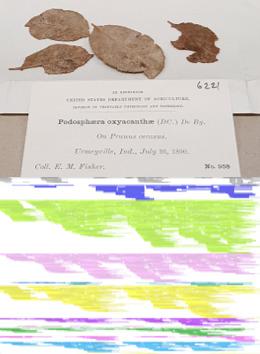当前位置:
X-MOL 学术
›
Plant Pathol.
›
论文详情
Our official English website, www.x-mol.net, welcomes your feedback! (Note: you will need to create a separate account there.)
Molecular data from up to 130‐year‐old herbarium specimens do not support the presence of cherry powdery mildew in Australia
Plant Pathology ( IF 2.7 ) Pub Date : 2020-11-15 , DOI: 10.1111/ppa.13316 Reannon L. Smith 1, 2 , Tom W. May 3 , Jatinder Kaur 1 , Tim Sawbridge 1, 2 , Ross Mann 1 , Jacky Edwards 1, 2
Plant Pathology ( IF 2.7 ) Pub Date : 2020-11-15 , DOI: 10.1111/ppa.13316 Reannon L. Smith 1, 2 , Tom W. May 3 , Jatinder Kaur 1 , Tim Sawbridge 1, 2 , Ross Mann 1 , Jacky Edwards 1, 2
Affiliation

|
A strain of Podosphaera clandestina has been highlighted as a priority pest threat to the Australian cherry industry. Australia currently has no records of powdery mildew on cherry (Prunus avium). P. clandestina is reported to cause disease on a range of Rosaceae genera including Crataegus and Prunus; in Australia, P. clandestina has only been recorded on Crataegus. A recent species revision identified Podosphaera cerasi on P. avium as a separate species from P. clandestina. Therefore, a revision of which powdery mildew species is present in Australia on Crataegus is required to inform Australian plant biosecurity. Reference collection specimens from the Victorian Plant Pathology Herbarium (VPRI) recorded as Podosphaera spp. collected between 1889 to 2008 on cherry and three other host plant genera from Australia and overseas were sampled for DNA extraction and next‐generation sequencing (NGS). Sequence data from preserved specimens were successfully mapped to internal transcribed spacer (ITS) sequences of P. clandestina in the strict sense, P. cerasi, and Podosphaera prunicola, and chloroplast matK sequences were used to identify plant hosts. Australian specimens on Crataegus hosts were P. clandestina in the strict sense and specimens on Prunus from the USA were identified as P. cerasi and P. prunicola. The outcome of this study confirmed the powdery mildew on Australian Crataegus specimens to be P. clandestina and none of the cherry powdery mildews (Podosphaera pruni‐avium, P. cerasi, or P. prunicola) are present on Australian specimens in the VPRI collection, which suggests they are not present in Australia.
中文翻译:

多达130年的植物标本室标本的分子数据不支持在澳大利亚存在樱桃白粉病
有人认为马铃薯Podosphaera clandestina菌株是对澳大利亚樱桃产业的主要害虫威胁。澳大利亚目前还没有对樱桃白粉病(记录甜樱桃)。据报道P. clandestina会引起蔷薇科属的疾病,包括Crataegus和Prunus ; 在澳大利亚,P。秘密记录仅在Crataegus上有记载。最近的物种鉴定修订的Podosphaera樱桃黑色轮斑上P.杆菌从一个独立的物种P。秘密。因此,需要对澳大利亚Crataegus上存在的白粉病菌种进行修订,以告知澳大利亚植物的生物安全性。来自维多利亚植物病理植物标本室(VPRI)的参考收集标本记录为Podosphaera spp。在1889年至2008年之间收集的来自澳大利亚和海外的樱桃和其他三个寄主植物属上的样本进行了DNA提取和下一代测序(NGS)。保存标本的序列数据已成功映射到P的内部转录间隔区(ITS)序列。clandestina从严格意义上讲,P。cerasi和P odosphaera prunicola和叶绿体matK序列用于鉴定植物宿主。澳大利亚标本山楂主人是P。clandestina严格意义和标本上李从美国被认定为P.樱桃黑色轮斑和P。prunicola。这项研究的结果证实了澳大利亚白粉病山楂标本是P。clandestina并且没有一个樱桃白粉病的(P odosphaera pruni -杆菌,P.樱桃黑色轮斑,或P。prunicola)出现在VPRI集合中的澳大利亚标本中,这表明它们在澳大利亚不存在。
更新日期:2020-11-15
中文翻译:

多达130年的植物标本室标本的分子数据不支持在澳大利亚存在樱桃白粉病
有人认为马铃薯Podosphaera clandestina菌株是对澳大利亚樱桃产业的主要害虫威胁。澳大利亚目前还没有对樱桃白粉病(记录甜樱桃)。据报道P. clandestina会引起蔷薇科属的疾病,包括Crataegus和Prunus ; 在澳大利亚,P。秘密记录仅在Crataegus上有记载。最近的物种鉴定修订的Podosphaera樱桃黑色轮斑上P.杆菌从一个独立的物种P。秘密。因此,需要对澳大利亚Crataegus上存在的白粉病菌种进行修订,以告知澳大利亚植物的生物安全性。来自维多利亚植物病理植物标本室(VPRI)的参考收集标本记录为Podosphaera spp。在1889年至2008年之间收集的来自澳大利亚和海外的樱桃和其他三个寄主植物属上的样本进行了DNA提取和下一代测序(NGS)。保存标本的序列数据已成功映射到P的内部转录间隔区(ITS)序列。clandestina从严格意义上讲,P。cerasi和P odosphaera prunicola和叶绿体matK序列用于鉴定植物宿主。澳大利亚标本山楂主人是P。clandestina严格意义和标本上李从美国被认定为P.樱桃黑色轮斑和P。prunicola。这项研究的结果证实了澳大利亚白粉病山楂标本是P。clandestina并且没有一个樱桃白粉病的(P odosphaera pruni -杆菌,P.樱桃黑色轮斑,或P。prunicola)出现在VPRI集合中的澳大利亚标本中,这表明它们在澳大利亚不存在。



























 京公网安备 11010802027423号
京公网安备 11010802027423号